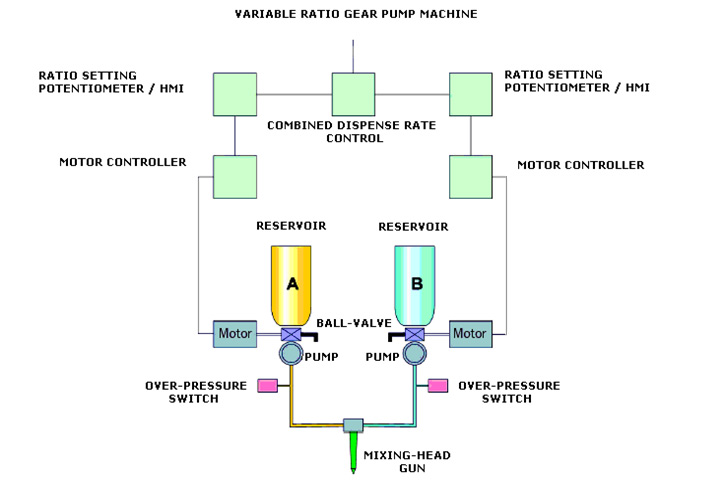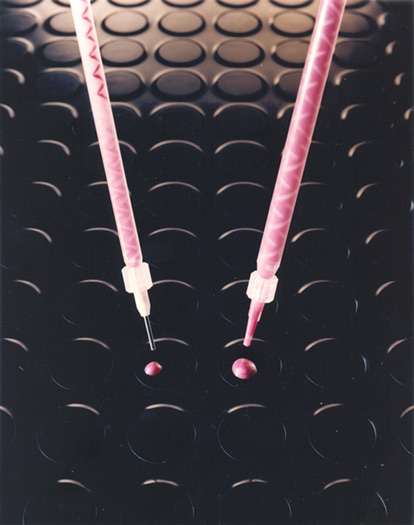The factors determining how the material components are fed to the metering pumps are; suppliers packaging, material usage, environmental issues, viscosity and the need for secondary preparation, such as heating.
If you have been buying the material small pre-weighed kits or in convenience duplex –side/side cartridge/ syringes then switching to buying in larger, bulk containers will often quickly amortise the capital purchase of a machine and after this improve your profitability. However the material will still need to be handled to transfer into a machine.
If the material is flowable it may be able to be fed from bulk (205L or 20/25L) drum. Ideally the pump should be lower than the drum to give head, but once primed the pump will generate suction. However at best this will only be 1Bar differential pressure and this may limit the feed rate. Changing the empty drums can be a problem, invariable it empties at the wrong time so the machine has to be stopped. Moreover air can be introduced and the pump may need bleeding. This can be overcome by using two drums with one drum above the other and tee’d together. With the additional head the top drum will empty first but leave the bottom drum full to give continuity of feed and time to change the top empty one.
However if the material is not flowable enough to feed from the drum it will transferred by a secondary pump. These are normally proprietary pneumatically powered and range from;
Diaphragm pump for low viscosity materials. These can be coupled to the drum with a hose or fitted with a dip tube which immerses into the drum. They have a 1:1 intensification ratio so will not generate much pump power. However as there are no wetted dynamic seals that may leak, they are ideal for pumping hygroscopic materials and can be made from plastic.
Ball type pump for low to medium viscosity materials. These can range from 1:1 up to 50+:1 intensification ratio, so are capable of transferring long distances and you can buy lower intensification pumps which can be immersed into the drum through the bung hole.
Extrusion pump for high viscosity, non flowable material, these normally range from 20 up to 60:1ratio and comprise a pump mounted into the middle of a follower plate with a wiper blade sized to the inside diameter of the drum. The assembly is fitted to a pneumatic lift or lift/ram so the drum can be slid underneath the follower and then lowered down inside the drum to rest on top of the material. The pump has to be bled of air but once primed and pumping the differential pressure will push the follower plate down.
However it takes times to change drums over, the machine has to be stopped and this may be a problem on a production line. To overcome the problem the extrusion pump can be used to feed to an accumulator close to the metering pump to act as a buffer and allow the time to change drums over. \these also act as a pressure reducer as metering pumps do not the high inlet pressure generated by the extrusion pump.
The alternative to a transfer pump is to meter directly from the drum, with either a piston or gear metering pump in the follower in place of the extrusion pump. On paper it looks the obvious method of handling thick materials in 205 or 25L drums, but in practise it can be fraught with problems. The most common being a dented drum which stops or let’s air in to the follower and throws the machine off mixing ratio.
However, most machines are fed from reservoirs. Once the material is inside it’s reservoir it should have the same shelf life as inside the supplied container. Therefore it is best to size the reservoir to be a minimum1.5 x the container size. Thus when the reservoir is empty it will accept a full container to be decanted in to it, then close the lid and the risk of contamination will be minimised. If you are using say 50L. of material per day and buying it in 20L drums make the material 70L capacity. Many materials are hygroscopic, sensitive to airborne moisture; the reservoir can be sealed and vented through a silica gel trap or fed with oxygen free (dry nitrogen). Therefore, so a rule the less the tank lid is off the better.
The 1 Bar suction from the pump applies to reservoirs and as they are normally coupled directly, or close to the pump simple gravity fed type will suffice. If not then overpressure is required say 2 or 5 Bar. Technically not an issue, but due to legislation making a one off bespoke tank is now very expensive, be prepared to compromise to if possible use a standard type pressure vessel.
The reservoirs are used for preparation of the material as this can be more easily done on a batch basis rather trying to do it online through the metering pumps a mixer. Normally what is fed into the metering pumps will come out through the mixer without entraining any air. So, if the material is poured in ‘air free’ it will come out air free. With many applications this is sufficient, but if there is air in the material this can affect the metering and/or the final product. Therefore the material has to be de-gassed in the reservoirs prior to metering. When the material is being degassed the entrained air in the material will expand and the material will rise in the reservoir, although the expansion is not as violent as degassing a hand mixed sample so allow for 1.5 to 2 x volume rise in the reservoir. With degassing, the larger surface area in contact with the applied vacuum the better. Thus a large diameter shallow is preferable to a small diameter deep reservoir. Stirring where fresh material is brought up to the surface in contact with the vacuum will speed up the process. Similarly ‘Thin Filming’ where the material is drawn up from the bottom of the reservoir then spread as a thin film over a plate will speed up degassing . Although as a stating point it is better to opt for a large diameter, shallow design.
Material may need to be heated for a number of reasons, they can be solid or waxy at room temperature, need to be mixed hot, too thick at ambient to flow easily or need to reduce the variability of the material by keeping the temperature up above ambient. As a general rule for epoxies and polyurethanes (PU) a 10Deg. C change in temperature will factor the viscosity times 2. So, clearly warming up a thick material will make it easier load and pump through the machine. However this times 2 figure also applies to the mixed gel time; this may sound like a worry, but often the mixed material is applied to or poured into a good heatsink that will cool it down. As such most materials are poor conductors; it takes time to heat up or cool down. Therefore heating is best done in the reservoirs where there is time to apply the heat, and if the rest of the machine has to be heated work on the basis that this will be holding, rather than elevating the temperature.
Heating the machine can be done by
Environmental; where the machine is enclosed in an insulated hot box warmed by infra red lamps or fan heater. This is simple, very effective as it warms the whole machine and can be used to pre-warmed material prior to decanting into the machine. There are limitations such as access to the machine. Although it can be done at low cost it seems to often overlooked.
Electrical; using trace wire for hoses or silicone rubber mats or cartridge heaters for the reservoirs and metering pumps. This is the most commonly used method. The heating can be targeted effectively although each zone needs to be controlled separately. Also there are limits to how much heat can be transferred without creating localised hot spots which may degrade the material.
Liquid; where the reservoirs and component hoses are fitted with outer jackets. Hot liquid (water up to 85deg.C or oil up to 150Deg.C) is then pump through them using a recirculatory heater unit. It is generally accepted liquid is the best heating method as it offers a uniform temperature over a large area. However it can be expensive if just heating one part/zone of the machine.
When heating reservoirs you may also have to consider stirring. This will help to speed up the heating process as it will bring fresh material in to contact with the heating surfaces. Also with filled material it will help to keep the filler in suspension.






